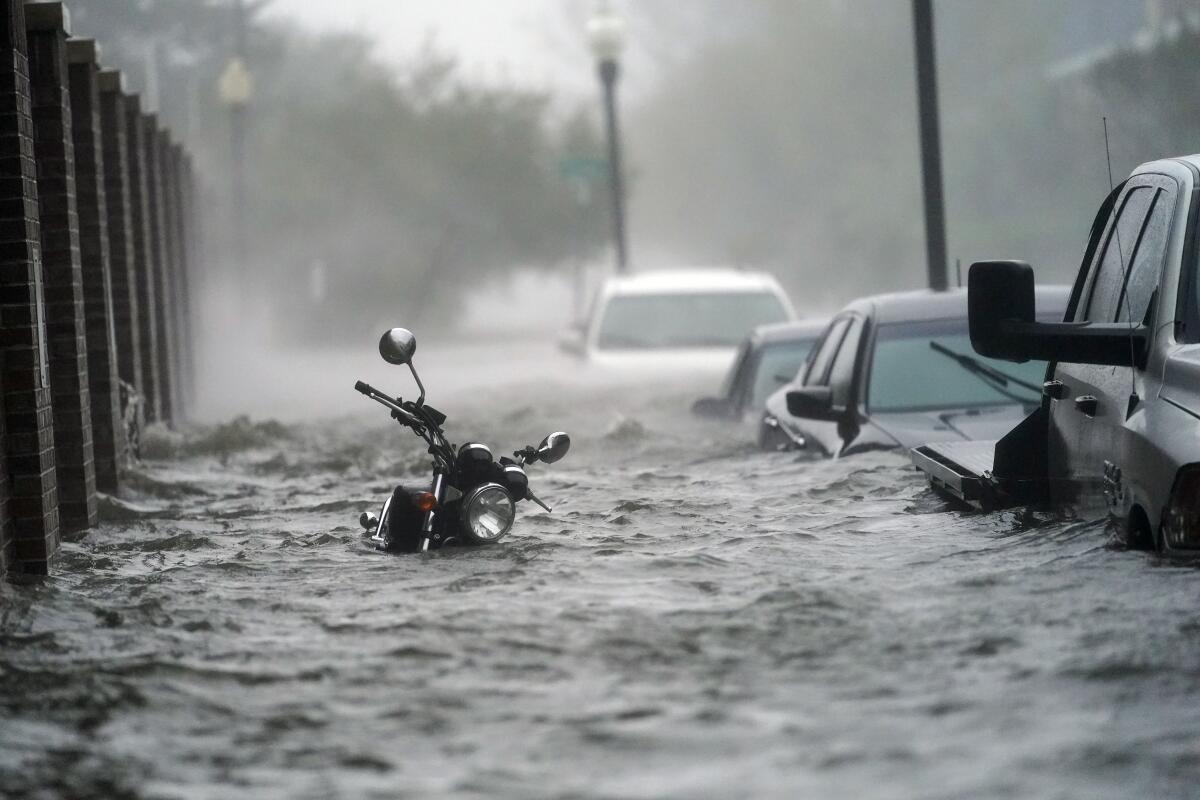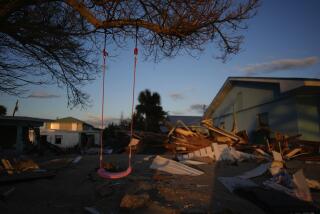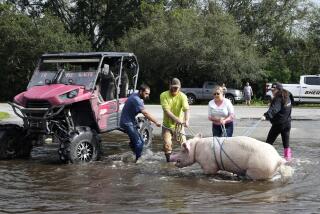At least one dead, hundreds rescued as Hurricane Sally drenches Deep South

- Share via
PENSACOLA, Fla. — Hurricane Sally lumbered ashore near the Florida-Alabama line Wednesday with 105-mph winds and rain measured in feet, not inches, killing at least one person, swamping homes and forcing the rescue of hundreds as it pushed inland for what could be a slow and disastrous drenching across the Deep South.
The death happened in Orange Beach, Ala., said Mayor Tony Kennon, who also told the Associated Press that one person was missing. Kennon said he couldn’t immediately release details.
Moving at an agonizing 3 mph, about the speed of a person walking, the storm made landfall at 4:45 a.m. close to Gulf Shores, Ala., about 30 miles from Pensacola. It accelerated to a light jog as it battered the Pensacola and Mobile, Ala., metropolitan areas encompassing nearly 1 million people.
Sally cast boats onto land and sank others at the dock, flattened palm trees, peeled away roofs, blew down signs and knocked out power to more than 540,000 homes and businesses. A replica of Christopher Columbus’ ship the Niña that had been docked at the Pensacola waterfront was missing, police said.
The storm tore loose a barge-mounted construction crane, which then smashed into the new Three Mile Bridge over Pensacola Bay, causing a section of the year-old span to collapse, authorities said. Sally also tore away a large section of a newly renovated fishing pier at Alabama’s Gulf State Park and knocked out power to more than half a million homes and businesses across the region.
By early afternoon, Sally had weakened into a tropical storm, with winds down to 70 mph, but the worst may be yet to come, with heavy rain expected into Thursday as the storm pushes inland over Alabama and into Georgia. It was moving at just 5 mph.
Authorities in Pensacola said 200 National Guard members would arrive Thursday to help. Curfews were announced in Escambia County and in some coastal Alabama towns.
At least eight waterways in south Alabama and the Florida Panhandle were expected to hit their major flood levels by Thursday. Some of the crests could break records, submerge bridges and flood some homes, the National Weather Service warned.
Sheriff David Morgan estimated thousands more would need to flee rising waters in the coming days. County officials urged residents to rely on text messages for contacting family and friends to keep cellphone service open for 911 calls.
“There are entire communities that we’re going to have to evacuate,” Morgan said. “It’s going to be a tremendous operation over the next several days.”
More than 2 feet of rain was recorded near Naval Air Station Pensacola, and nearly 3 feet of water covered streets in downtown Pensacola, the National Weather Service reported.
“It’s not common that you start measuring rainfall in feet,” said forecaster David Eversole. “Sally’s moving so slowly, so it just keeps pounding and pounding and pounding the area with tropical rain and just powerful winds. It’s just a nightmare.”
It was the second hurricane to hit the Gulf Coast in less than three weeks and the latest blow in one of the busiest hurricane seasons ever recorded, so frenetic that forecasters have nearly run through the alphabet of storm names with 2½ months still to go. At the start of the week, Sally was one of a record-tying five storms churning simultaneously in the Atlantic, strung out like charms on a bracelet.
Like the wildfires raging on the West Coast, the onslaught of hurricanes has focused attention on climate change, which scientists say is causing slower, rainier, more powerful and more destructive storms.
An emergency crew rescued two people on Dauphin Island, Ala., after the hurricane ripped the roof off their home and the rest of the house began to crumble.
“As things started to peel off and fall apart, they got scared and called for assistance,” Dauphin Island Mayor Jeff Collier said by phone. He said no one was injured.
In Orange Beach, Ala., winds blew out the walls in one corner of a condominium building, exposing the interiors of condos on at least five floors, video posted online showed. Other images showed boats shoved onshore by storm surge.
“We got a few people that we just haven’t been able to get to because the water is so high,” Kennon said. “But they are safe in their home; as soon as the water recedes, we will rescue them.”
Streetlights were knocked out in downtown Mobile. Trees bent in the howling wind as the rain blew sideways. In downtown Pensacola, water rushed down some streets like river rapids, forming whitecaps as it slapped against buildings and rose above the tires on cars.
Before sunrise, water was up to the doors of Jordan Muse’s car outside the Pensacola hotel where her family took shelter after fleeing their mobile home a few miles away. The power failed early in the morning, making it too stuffy to sleep. Her 8-year-old son played with toys underneath the hotel room’s desk as Muse peered out the window, watching rain fly by in sheets.
“The power trucks are the only ones above water, and they’re the biggest,” Muse said. “I can’t believe it got so bad.”
Michele Lamar-Acuff woke to the thud of a small tree falling against a window of her Pensacola home. Waist-deep water gushed down her street. Above the loud whistling of the wind she heard what sounded like transformers exploding.
“I don’t feel safe to leave,” Lamar-Acuff said from the porch of a neighbor’s house. “I’m just staying put and hoping for the best.”
National Hurricane Center forecaster Stacy Stewart said the rain will be “catastrophic and life-threatening” over portions of the Gulf Coast.
“Sally has a characteristic that isn’t often seen and that’s a slow forward speed, and that’s going to exacerbate the flooding,” said Ed Rappaport, deputy director of the hurricane center. He likened the storm’s plodding pace to that of Hurricane Harvey, which inundated Houston in 2017.
Sally’s slow crawl made it hard to predict where it would strike. Just two days before landfall, the storm was forecast to hit New Orleans — 140 miles west of where it came ashore.
So Robert Lambrisky and his husband were caught somewhat off guard when the hurricane shook their door before daybreak and forced rainwater inside their home in Sanders Beach near Pensacola. After sunrise, choppy seawater covered what is normally 50 feet of beach.
“We had some warning, but this was just such a strange storm,” Lambrisky said. “So all of this preparing that you do, when you know the storm is coming, was something we only half did because we were convinced the storm wasn’t going to hit us.”
Sally’s effects were felt all along the northern Gulf Coast. Low-lying properties in southeastern Louisiana were swamped by the surge. Water covered Mississippi beaches and parts of the highway that runs parallel to them.
President Trump issued emergency declarations for parts of Florida, Alabama, Mississippi and Louisiana. White House Press Secretary Kayleigh McEnany said on Fox News Channel that Trump was in contact with the states’ governors and ready to help “in every way possible.”
Hurricane Laura pummeled southwestern Louisiana on Aug. 27. Thousands of people were still without power from that storm, and some were still in shelters.
Meanwhile, far out in the Atlantic, Teddy became a hurricane Wednesday with winds of 100 mph. Forecasters said it could reach Category 4 strength before closing in on Bermuda, which took a direct hit from Hurricane Paulette only days ago.
More to Read
Sign up for Essential California
The most important California stories and recommendations in your inbox every morning.
You may occasionally receive promotional content from the Los Angeles Times.










